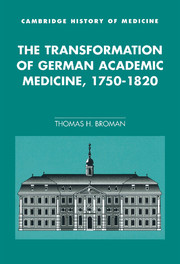Book contents
- Frontmatter
- Contents
- Acknowledgments
- Introduction
- 1 Physicians in eighteenth-century Germany
- 2 Fractures and new alignments
- 3 Physicians and writers: Medical theory and the emergence of the public sphere
- 4 The art of healing
- 5 Breaking the shackles of history: The Brunonian revolution in Germany
- 6 German academic medicine during the reform era
- Conclusion: Disciplines, professions, and the public sphere
- Index
- Cambridge History of Medicine
2 - Fractures and new alignments
Published online by Cambridge University Press: 30 September 2009
- Frontmatter
- Contents
- Acknowledgments
- Introduction
- 1 Physicians in eighteenth-century Germany
- 2 Fractures and new alignments
- 3 Physicians and writers: Medical theory and the emergence of the public sphere
- 4 The art of healing
- 5 Breaking the shackles of history: The Brunonian revolution in Germany
- 6 German academic medicine during the reform era
- Conclusion: Disciplines, professions, and the public sphere
- Index
- Cambridge History of Medicine
Summary
Of necessity, the image of mid-eighteenth century German medicine presented in the preceding chapter was one frozen in time. Yet the constituents of that picture – the intimate connection between medical profession and the universities, and the location of both in the larger society – should be conceived of dynamically, not statically. For all its seeming clarity, as soon as the depth provided by time is added to the picture, the details begin to blur and lose their sharp outline. At no time were there ever institutions such as “the medical profession” or “the universities” for which we can give a precise description. Rather, such institutions are always a more or less discordant blend of meanings and functions, incessantly driven in new directions by unfulfilled expectations (which can themselves be dissonant) and held back by the weight of established practices. If these institutions appear stable at mid-century, it is only in comparison to the changes that would overtake them in the years around 1800.
It is worth remembering this when we consider the forces that acted upon the universities and the medical profession, propelling them into a new relationship. These forces did not act on inert matter. There was no reform “movement” that suddenly arose in the 1700s to resuscitate a group of “outmoded” universities and incompetent physicians.
- Type
- Chapter
- Information
- Publisher: Cambridge University PressPrint publication year: 1996

